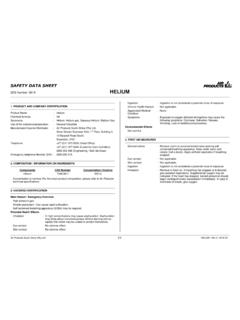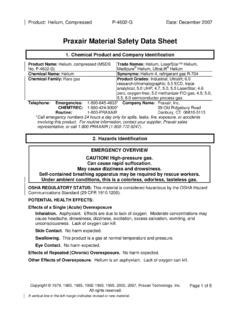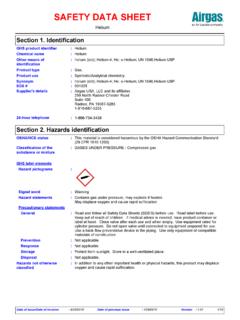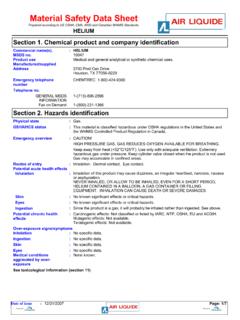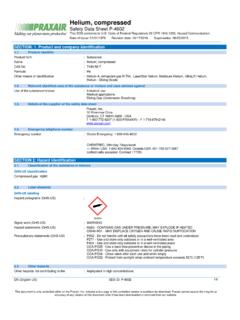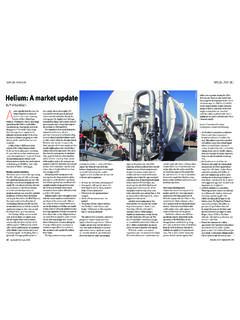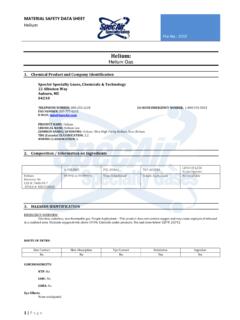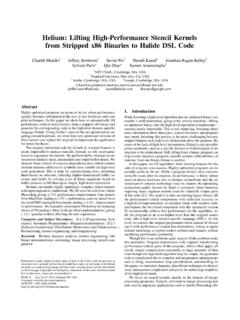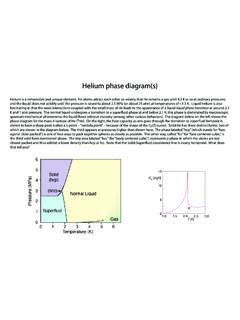Transcription of Helium-Neon Laser
1 Helium-Neon Laser1 IntroductionThe Helium-Neon Laser , short HeNe- Laser , is one of the most common used Laser for allignement,reference Laser and optics demonstrations. Its most used wavelength is at (red). It alsohas lasing transition in IR, orange and green. This experiment will make you familiar with basiccavity alignement procedures, cavity characteristics, beam profile analysis and Gaussian Helium-Neon Gain MediumThe Gain medium is a mixture of the two gases helium and Neon. Mostly the mixture rangesfrom 5:1 to 20:1 ratios with relativly low pressure.
2 A high voltage source (typical value of1kV) is exciting the helium atoms to long-lived, meta-stable states. Collisions of the excitedHelium atoms with the ground state Neon atoms results in a transfer of the energy. The excitedNeon atom can relax to ground state by spontaneous and stimulated emission of a photon. Thestrongest transitions are at m and m. In the visible, transitions at nm (green,measured in vacuum), 594 nm (yellow) and 612 nm (orange) excists. The typical red Laser usesthe transition at nm(measured in air).
3 Laser CavityA Laser cavity is a resonant feedback system necessary for a Laser . They can be setup in a ring orlinear configuration. In this experiement, you will build a linear cavity composed of two curvedmirrors. For resonance condition, there has to be integral numbers of half wavelength in betweenthese two mirrorsL=q 2n(1)where L is the length of the cavity, the wavelength, n the refractive index and q an (1) can be rewriten in terms of frequency =qc2nL,(2)wherecis the speed of light in vacuum. This means only discrete frequencies are resonant insidethe cavity and contribute to the lasing.
4 These fequencies are also called longitudinal , the lasing modes are defined by the overlap of the gain medium spectrum and thecavity Hermite-Gaussian or tranverse ModesIn the paraxial aproximation, the solution to the wave equation are pure transverse electric andmagnetic (TEM) waves. In this experiement, you will investigate some properties of TEM00(Gaussian) and TEM01modes. These modes are called transverse modes in a Laser . In figure 1the three different TEM-modes are shown. These TEM modes also affect the longitudanal modes,since the phase shift of higher Hermit-Gaussian modes is more complicated when propagating1from one side of the cavity to the other one.
5 (Note: the phase shift description is just a differentinterpretation of the integers half wavelength that fit inside the resonator). So the frequenciesof the TEMm,p,qcan be written in the form: m,p,q=c2nL[q+1 +m+p cos 1(g1g2)1/2](3)withg1,2= 1 LR1,2whereR1,2are the radius of curvatures of the 1:The intensity profile of a TEM00(left), the TEM10(middle) and the TEM11(right) Basic cavity alignmentFor the alignment, we will use another He-Ne Laser to perform the alignment of this Laser , whichbrings the question of the egg and the chicken: how were the first He-Ne lasers aligned?
6 My oldBoss at Philips Research Labs in Eindhoven had his technique. He looked down the tube, tocenter the image of the pupil of his eye. Then he placed the second mirror, lined it up, and ..jumped away when the Laser oscillation Alignment of a Long Laser Tube: The Virtual PivotHeNe and Argon lasers typically have very small bore diameters. It is therefore difficult to sendan alignment Laser beam through these tubes. In addition, the Laser manufacturer makes yourlife most difficult by locating the external cavity mirrors so close to the tube, that there is noway to insert any sophisticated mirror mount between the end mirror mount and the solution is an optical arrangement that enables you to rotate the beam around a pivotpoint located at the tube entrance.
7 The optical setup should also allow for independent posi-tioning of this pivot point . The principle of such a setup is described below in Fig. two lens combination can be used to obtain an ideal alignment beam: a diameter smallenough to penetrate the capillary tube of the Laser , yet not too small in order to have a reasonabledivergence (say a waist of 850 m over 3 meters). In order to align the beam with the axis ofthe tube, it should be rotated around a point A located at the tube entrance (where it is ofcourse not possible to position a mirror).
8 The solution is to have the point A (the virtual pivotpoint ) be the image of a real pivot pointA0as sketched in Fig. 2:The virtual pivot. Note: The HeNe symbol here refers to a combination of a HeNe Laser andoptics that ensure minimal divergence, a well-collimated A is the image ofA0in the geometrical optics approximation, one sees that:1A0P=1f2 1AP(4)Givenf2andAP (a convenient working distance from the tube), one can position the lens L1, the telescope system of lenses L1L2should beconfocal(in order totransform one collimated beam into another collimated beam).
9 One determines the distanceHA0from the relationHA0+A0P =f1+ adjustment of the distanceA0P is required to correct for the fact that the geometricaloptics approximation was used to position the lenses (in order to obtain the minimum divergencefor the beam).Verify the existence and position of a virtual pivot point .Tips for alignment:Make sure the HeNe alignment Laser is horizontal all the way along the optics table, evenafter every optics (mirrors, lenses). You need to budget 10% of your time on sure the HeNe alignment Laser hit the pivot of mirror M1.
10 It should be mounted on amount with it s pivot on the center of the mirror, but not outside. In this case you acquire anindependent adjustment of beam a 50-50 beamsplitter, position the point A at the entrance face of the Laser tube tobe aligned (see Fig. 3). Lens L2 is mounted on a 3-dimention translation stage to providean independent position adjustment of virtual pivot A. Now you have both beam directionadjustment (by M1) and position adjustment (by L2).3 Figure 3: Laser alignment with the virtual Beam Profile Measurements1.
